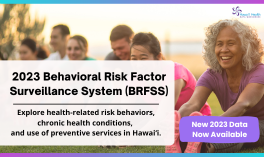The Pregnancy Risk Assessment and Monitoring System (PRAMS) collects state-specific, population-based data on maternal attitudes and experiences before, during, and shortly after pregnancy in 46 states, including Hawaiʻi. HHDW users can explore over 150 PRAMS data health indicators at the state and county level from 2000-2021.
Here are some highlights from the 2021 PRAMS:
- The percentage of mothers who received early and adequate prenatal care was significantly higher in Kauaʻi County (82.7%) and Maui County (77.6%), compared to Honolulu County (59.4%) and Hawaiʻi County (58.1%).
- E-cigarette and other electronic nicotine product use during the 3 months before pregnancy nearly doubled from 4.8% in 2016 to 9.2% in 2020. However, the rate decreased to 6.4% in 2021.
- 40.2% of mothers had their teeth cleaned by a dentist or hygienist during the 12 months before they got pregnant, compared to 44.6% while they were pregnant and 32.2% after their baby was born.
- The percentage of mothers who received a flu shot in the 12 months before delivery was significantly higher in Honolulu County (67.9%) than in all other counties (46.4% in Maui, 45.6% in Kauaʻi, and 34.3% in Hawaiʻi).
- The percentage of mothers who reported having signs of postpartum depression was highest among Other Pacific Islanders (21.8%), followed by White (15.4%), Native Hawaiian (14.0%), Filipino (14.0%), Japanese (13.1%), Chinese (11.4%) and Other Asian (10.1%).
- 88.7% of women have had a postpartum checkup since their baby was born. Of those who received a check-up, 90.3% discussed birth control methods to use after giving birth, 42.0% were prescribed a contraceptive method, and 21.5% had an IUD inserted.
- 94.1% of women were told by a health care worker to place their baby on his or her back to sleep. The majority of mothers reported most often positioning their baby to sleep on their backs (83.0%), followed by their side (7.8%), more than 1 position (5.7%) and stomach (3.4%).
Hawaiʻi PRAMS is conducted by the Hawaiʻi State Department of Health, Family Health Services Division in collaboration with the Centers for Disease Control and Prevention (CDC). The data is collected through a combination of written and telephone surveys of new mothers to monitor maternal behaviors to determine how to reduce infant deaths, decrease low birth weights and improve the overall health of the population in Hawaiʻi.




